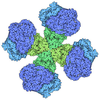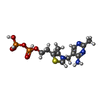[English] 日本語
 Yorodumi
Yorodumi- PDB-8io6: Cryo-EM structure of phosphoketolase from Bifidobacterium longum ... -
+ Open data
Open data
- Basic information
Basic information
| Entry | Database: PDB / ID: 8io6 | |||||||||
|---|---|---|---|---|---|---|---|---|---|---|
| Title | Cryo-EM structure of phosphoketolase from Bifidobacterium longum in octameric assembly | |||||||||
 Components Components | Xylulose5phosphatefructose6phosphate phosphoketolase | |||||||||
 Keywords Keywords |  CYTOSOLIC PROTEIN / Carbon metabolism / TPP-dependent enzyme CYTOSOLIC PROTEIN / Carbon metabolism / TPP-dependent enzyme | |||||||||
| Function / homology |  Function and homology information Function and homology information | |||||||||
| Biological species |   Bifidobacterium longum subsp. longum F8 (bacteria) Bifidobacterium longum subsp. longum F8 (bacteria) | |||||||||
| Method |  ELECTRON MICROSCOPY / ELECTRON MICROSCOPY /  single particle reconstruction / single particle reconstruction /  cryo EM / Resolution: 2.68 Å cryo EM / Resolution: 2.68 Å | |||||||||
 Authors Authors | Chang, C.-W. / Tsai, M.-D. | |||||||||
| Funding support |  Taiwan, 2items Taiwan, 2items
| |||||||||
 Citation Citation |  Journal: Nat Metab / Year: 2023 Journal: Nat Metab / Year: 2023Title: An ATP-sensitive phosphoketolase regulates carbon fixation in cyanobacteria. Authors: Kuan-Jen Lu / Chiung-Wen Chang / Chun-Hsiung Wang / Frederic Y-H Chen / Irene Y Huang / Pin-Hsuan Huang / Cheng-Han Yang / Hsiang-Yi Wu / Wen-Jin Wu / Kai-Cheng Hsu / Meng-Chiao Ho / Ming- ...Authors: Kuan-Jen Lu / Chiung-Wen Chang / Chun-Hsiung Wang / Frederic Y-H Chen / Irene Y Huang / Pin-Hsuan Huang / Cheng-Han Yang / Hsiang-Yi Wu / Wen-Jin Wu / Kai-Cheng Hsu / Meng-Chiao Ho / Ming-Daw Tsai / James C Liao /  Abstract: Regulation of CO fixation in cyanobacteria is important both for the organism and global carbon balance. Here we show that phosphoketolase in Synechococcus elongatus PCC7942 (SeXPK) possesses a ...Regulation of CO fixation in cyanobacteria is important both for the organism and global carbon balance. Here we show that phosphoketolase in Synechococcus elongatus PCC7942 (SeXPK) possesses a distinct ATP-sensing mechanism, where a drop in ATP level allows SeXPK to divert precursors of the RuBisCO substrate away from the Calvin-Benson-Bassham cycle. Deleting the SeXPK gene increased CO fixation particularly during light-dark transitions. In high-density cultures, the Δxpk strain showed a 60% increase in carbon fixation and unexpectedly resulted in sucrose secretion without any pathway engineering. Using cryo-EM analysis, we discovered that these functions were enabled by a unique allosteric regulatory site involving two subunits jointly binding two ATP, which constantly suppresses the activity of SeXPK until the ATP level drops. This magnesium-independent ATP allosteric site is present in many species across all three domains of life, where it may also play important regulatory functions. | |||||||||
| History |
|
- Structure visualization
Structure visualization
| Structure viewer | Molecule:  Molmil Molmil Jmol/JSmol Jmol/JSmol |
|---|
- Downloads & links
Downloads & links
- Download
Download
| PDBx/mmCIF format |  8io6.cif.gz 8io6.cif.gz | 1 MB | Display |  PDBx/mmCIF format PDBx/mmCIF format |
|---|---|---|---|---|
| PDB format |  pdb8io6.ent.gz pdb8io6.ent.gz | 912.2 KB | Display |  PDB format PDB format |
| PDBx/mmJSON format |  8io6.json.gz 8io6.json.gz | Tree view |  PDBx/mmJSON format PDBx/mmJSON format | |
| Others |  Other downloads Other downloads |
-Validation report
| Arichive directory |  https://data.pdbj.org/pub/pdb/validation_reports/io/8io6 https://data.pdbj.org/pub/pdb/validation_reports/io/8io6 ftp://data.pdbj.org/pub/pdb/validation_reports/io/8io6 ftp://data.pdbj.org/pub/pdb/validation_reports/io/8io6 | HTTPS FTP |
|---|
-Related structure data
| Related structure data |  35609MC 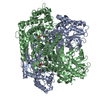 8io7C 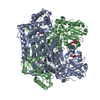 8io8C 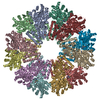 8io9C  8ioaC  8ioeC M: map data used to model this data C: citing same article ( |
|---|---|
| Similar structure data | Similarity search - Function & homology  F&H Search F&H Search |
- Links
Links
- Assembly
Assembly
| Deposited unit | 
|
|---|---|
| 1 |
|
- Components
Components
| #1: Protein | Mass: 92621.125 Da / Num. of mol.: 8 Source method: isolated from a genetically manipulated source Source: (gene. exp.)   Bifidobacterium longum subsp. longum F8 (bacteria) Bifidobacterium longum subsp. longum F8 (bacteria)Production host:   Escherichia coli (E. coli) / References: UniProt: S6CP45 Escherichia coli (E. coli) / References: UniProt: S6CP45#2: Chemical | ChemComp-TPP /  Thiamine pyrophosphate Thiamine pyrophosphate#3: Chemical | ChemComp-MG / Has ligand of interest | Y | |
|---|
-Experimental details
-Experiment
| Experiment | Method:  ELECTRON MICROSCOPY ELECTRON MICROSCOPY |
|---|---|
| EM experiment | Aggregation state: PARTICLE / 3D reconstruction method:  single particle reconstruction single particle reconstruction |
- Sample preparation
Sample preparation
| Component | Name: Bifidobacterium longum XFPK in complex with TPP/Mg2+ / Type: COMPLEX / Entity ID: #1 / Source: RECOMBINANT |
|---|---|
| Molecular weight | Value: 0.75 MDa / Experimental value: NO |
| Source (natural) | Organism:  Bifidobacteriaceae bacterium (bacteria) Bifidobacteriaceae bacterium (bacteria) |
| Source (recombinant) | Organism:   Escherichia coli (E. coli) Escherichia coli (E. coli) |
| Buffer solution | pH: 7.2 |
| Specimen | Conc.: 0.4 mg/ml / Embedding applied: NO / Shadowing applied: NO / Staining applied : NO / Vitrification applied : NO / Vitrification applied : YES : YES |
| Specimen support | Grid material: COPPER / Grid mesh size: 300 divisions/in. / Grid type: Quantifoil R1.2/1.3 |
Vitrification | Cryogen name: ETHANE |
- Electron microscopy imaging
Electron microscopy imaging
| Experimental equipment |  Model: Titan Krios / Image courtesy: FEI Company |
|---|---|
| Microscopy | Model: FEI TITAN KRIOS |
| Electron gun | Electron source : :  FIELD EMISSION GUN / Accelerating voltage: 300 kV / Illumination mode: FLOOD BEAM FIELD EMISSION GUN / Accelerating voltage: 300 kV / Illumination mode: FLOOD BEAM |
| Electron lens | Mode: BRIGHT FIELD Bright-field microscopy / Nominal magnification: 105000 X / Nominal defocus max: 2500 nm / Nominal defocus min: 500 nm / Cs Bright-field microscopy / Nominal magnification: 105000 X / Nominal defocus max: 2500 nm / Nominal defocus min: 500 nm / Cs : 2.7 mm : 2.7 mm |
| Specimen holder | Cryogen: NITROGEN / Specimen holder model: FEI TITAN KRIOS AUTOGRID HOLDER |
| Image recording | Average exposure time: 2.5 sec. / Electron dose: 42 e/Å2 / Detector mode: SUPER-RESOLUTION / Film or detector model: GATAN K3 BIOQUANTUM (6k x 4k) / Num. of grids imaged: 1 / Num. of real images: 6289 |
| Image scans | Movie frames/image: 40 |
- Processing
Processing
| EM software |
| ||||||||||||||||
|---|---|---|---|---|---|---|---|---|---|---|---|---|---|---|---|---|---|
CTF correction | Type: PHASE FLIPPING AND AMPLITUDE CORRECTION | ||||||||||||||||
3D reconstruction | Resolution: 2.68 Å / Resolution method: FSC 0.143 CUT-OFF / Num. of particles: 590627 / Num. of class averages: 3 / Symmetry type: POINT | ||||||||||||||||
| Atomic model building | Protocol: RIGID BODY FIT / Space: REAL | ||||||||||||||||
| Atomic model building | PDB-ID: 3AI7 Accession code: 3AI7 / Source name: PDB / Type: experimental model |
 Movie
Movie Controller
Controller







 PDBj
PDBj